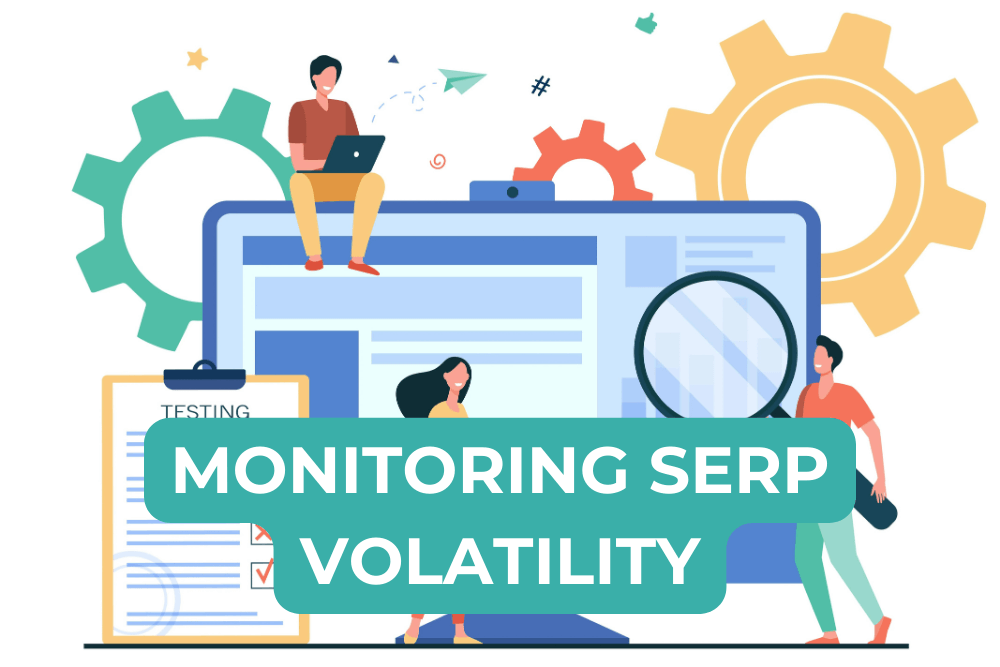How to Track & Combat SERP Volatility
SERP volatility can be quite the rollercoaster in the world of SEO. When major players like Google and Bing decide to shake up their algorithms, it’s a wild ride for your website’s rankings.
If you’ve noticed your position in the search results taking a bumpy journey through 2023, congratulations, you’ve had a firsthand encounter with SERP volatility. In this blog, we’ll dive into what causes this turbulence and how you can navigate it to keep your website on a steady course.
Imagine this: You’ve spent countless hours fine-tuning your website, optimizing your content, and climbing the ladder of search engine rankings. Your efforts have finally paid off, and you find your site comfortably perched at the top of Google’s search results. But then, without warning, everything goes haywire. Your rankings plummet one day, only to skyrocket the next. You’ve just experienced SERP volatility – the wild, unpredictable ride that can make or break your online presence.
Today, we’re delving deep into the turbulent world of Search Engine Results Page (SERP) volatility. In the next few minutes, you’ll discover the twists and turns, the reasons behind the rollercoaster, and, most importantly, how to steer your website through the SEO storm to reach the coveted summit of oragnic search results. Buckle up because this is a journey no website owner can afford to ignore.

What is SERP Volatility? Unraveling the SEO Rollercoaster
SERP volatility, or Search Engine Results Page volatility, is the phenomenon that keeps SEO experts and website owners on their toes. It’s the unpredictable, ever-shifting landscape of search engine rankings. But let’s break it down in simpler terms.
1. The SERP Defined
The Search Results Pages is where you see the list of websites displayed when you type a search query into Google or Bing.
It’s like the scoreboard of a game, showing which websites rank where for a particular keyword.
2. The Volatility Factor
SERP volatility refers to the constant changes in these rankings.
Imagine your website’s position in the search results as a rollercoaster – it goes up, it goes down, and sometimes it loops unexpectedly.
3. Why Does It Happen?
Search engines like Google are like ever-evolving puzzle masters.
They frequently tweak their algorithms (the rules that determine ranking) to provide users with better organic listings.
These changes can send shockwaves through the rankings, affecting your website’s visibility at the top of the SERP.
4. The Rollercoaster Ride
Simply put, SERP volatility is like a rollercoaster ride for website owners who want to be in SERP features like knowledge graphs, rich snippets, shopping results, and featured snippets.
It can send your website from page one to page ten and back within a short span.
These ups and downs can leave you exhilarated or queasy, depending on how you handle them.
Causes of SERP Volatility
SERP volatility isn’t a random occurrence. It’s driven by a combination of factors that are akin to the unseen forces behind a rollercoaster’s twists and turns. Understanding these causes is essential for managing and mitigating the impact of SERP volatility. Let’s uncover the culprits:
1. Algorithm Updates
Search engines, particularly Google SERP, frequently update their algorithms.
These updates are designed to improve the quality of search results, but they can shake up the rankings.
Major algorithm updates can lead to substantial shifts in rankings, making websites that were on top suddenly plummet and vice versa.
2. Competitor Activity
Your competitors are also vying for top positions in search results.
When they make changes to their websites, optimize their content, or acquire high-quality backlinks, it can affect your rankings.
Increased competition can lead to more volatile SERPs.
3. User Behavior
The way users interact with search results plays a crucial role.
If users click on a lower-ranked website more often, it sends a signal to the search engine that it should move that site up.
User behavior can influence the rankings, creating fluctuations.
4. Search Intent Variations
Changes in what users are searching for can also cause SERP volatility.
Shifts in search intent or the types of content that users prefer can impact which websites rise or fall in rankings.
5. Seasonal Trends
Some industries experience seasonal fluctuations in demand.
This can affect which websites are more relevant during specific times of the year, leading to periodic SERP volatility.
6. Technical Issues: SERP volatility
Understanding these causes of SERP volatility is the first step in managing and adapting to the ever-changing SEO landscape. In the following sections, we’ll explore how these factors impact your rankings and provide strategies to navigate this dynamic terrain.

Impact on Rankings
SERP volatility isn’t just a theoretical concept; it has tangible consequences for your website’s rankings and overall online success. Let’s dive into how these ups and downs can impact your web presence:
1. Ranking Fluctuations
The most immediate impact of SERP volatility is the rollercoaster ride your website experiences in search results.
Your site can bounce between high and low positions, making it challenging to maintain a stable audience.
2. Organic Traffic Changes
The changes in rankings directly affect the amount of organic traffic your website receives.
When you’re on the first page, you tend to get more clicks, which can significantly increase your web traffic.
3. User Trust and Credibility
Consistency in search results can contribute to user trust.
Frequent fluctuations may lead users to perceive your site as less reliable, impacting your online credibility.
4. Conversion Rates
Landing on the first page of search results often means more conversions, such as sales or sign-ups.
Volatility can disrupt this flow, affecting your conversion rates and, ultimately, your revenue.
5. SEO Efforts and Costs
Managing SERP volatility requires ongoing SEO efforts and adjustments.
This can increase the time and resources you need to maintain or improve your rankings.
6. User Experience
Users who land on your site after seeing it in the top results expect a certain level of quality.
If rankings fluctuate too often, it can disrupt the user experience and lead to high bounce rates.
Star ratings, knowledge panels, and Google ads affect organic search results. So, optimize for them.
7. Competitor Influence
Your competitors are also affected by SERP volatility.
Their changes in rankings can impact your competition, making the landscape more unpredictable.
8. Marketing Strategies
Your marketing strategies, including paid advertising (pay per click), may need to adapt to offset the impact of ranking changes.
Managing the impact of SERP volatility on your website is crucial for your online success. In the following sections, we’ll explore how to monitor these changes and implement strategies to stay ahead in the SEO game, even when the rollercoaster takes unexpected turns.
Monitoring SERP Volatility: Staying Ahead of the SEO Storm
To successfully navigate the ever-shifting world of SERP volatility, you need to keep a watchful eye on how your website ranks in search engine results. Fortunately, there are several tools at your disposal to help monitor these fluctuations and make informed decisions. Here are four reliable tools for keeping track of SERP volatility:
1. SEMrush Sensor
SEMrush Sensor is a robust tool that provides daily tracking of Google algorithm changes.
It uses a ‘SERP Volatility’ metric to quantify the turbulence in search results.
Users can set up alerts to stay informed about significant changes that may affect their rankings.
2. Mangools
Mangools offers a suite of SEO tools, including the SERPWatcher, for tracking keyword rankings.
It provides daily updates on your keyword positions, allowing you to detect changes in real time.
Customizable alerts help you react promptly to fluctuations.
3. Algoroo
Algoroo is a specialized tool focused on tracking Google algorithm fluctuations.
It uses a unique ‘Roo’ scale to measure the impact of changes on search results.
Historical data allows you to identify long-term trends in SERP volatility.
4. cognitiveSEO
cognitiveSEO provides a comprehensive SERP fluctuation tool called the “SERP Volatility Index.”
This tool tracks volatility on a daily, weekly, and monthly basis.
It allows you to assess the risk associated with specific keywords and adjust your strategy accordingly.
Using these tools, you can monitor your website’s performance in the face of SERP volatility, helping you stay proactive and respond to changes swiftly. Regularly checking the metrics and data provided by these tools is crucial to understanding how algorithm updates and other factors impact your rankings.
Coping Strategies: Navigating the SERP Rollercoaster
When your website is on a rollercoaster ride through the ever-changing landscape of SERP volatility, it’s essential to have strategies in place to manage the ups and downs. Here are some effective coping strategies to help you maintain your SEO success:
1. Content Optimization
Regularly update and improve your website’s content.
Focus on providing high-quality, valuable information that keeps visitors engaged.
Monitor your content’s performance and make data-driven adjustments.
2. Diversifying Traffic Sources
Relying solely on search engine traffic can be risky.
Explore other avenues, such as social media, email marketing, and paid advertising, to diversify your traffic sources.
This can mitigate the impact of ranking fluctuations.
3. Staying Updated with SEO Best Practices
Keep a close eye on SEO news and trends.
Stay informed about search engine algorithm changes and adapt your strategies accordingly.
Engage in continuous learning to keep your SEO skills sharp.
4. Strategic Keyword Targeting
Choose keywords strategically based on search intent.
Prioritize long-tail keywords and phrases that are less susceptible to intense competition and volatility.
5. Building a Strong Backlink Profile
High-quality backlinks can provide stability in rankings.
Focus on acquiring links from authoritative and relevant sources to strengthen your website’s authority.
6. Mobile Optimization
With the increasing use of mobile devices, ensure your website is mobile-friendly.
Mobile optimization can positively impact rankings, especially for users on smartphones and tablets.
7. Monitor and Adapt
Continuously monitor your website’s performance using the tools mentioned earlier.
Be prepared to adapt your strategies swiftly when significant changes occur.
8. User Experience Enhancement
A positive user experience can reduce bounce rates and improve rankings.
Focus on website speed, mobile-friendliness, and easy navigation.
9. Content Diversification
Explore different types of content, such as videos, infographics, and podcasts.
Diversifying your content can attract a wider audience and reduce the impact of SERP volatility on a single type of content.
10. Preparedness for Penalties
Adhere to search engine guidelines to avoid penalties.
Have a plan in place to address any potential penalties swiftly.
By implementing these coping strategies, you can minimize the impact of SERP volatility and maintain a more stable and successful online presence. Keep in mind that SEO is an ongoing process, and adapting to changes is key to long-term success in the ever-evolving world of search engine optimization.
Riding the SERP Rollercoaster
In the dynamic realm of SEO, SERP volatility is the rollercoaster ride you never quite buy a ticket for but end up taking nonetheless. It’s a test of your adaptability and resilience in the face of ever-changing search engine algorithms and user behavior.
Today, we’ve journeyed through the twists and turns of SERP volatility, understanding what it is, its causes, and its impact on your website’s rankings. We’ve explored the tools available to monitor these fluctuations and unveiled strategies to cope with the SEO rollercoaster.
Remember, staying informed, being proactive, and continuously optimizing your website and content are the keys to success in this rollercoaster ride. SERP volatility is a challenge, but with the right strategies and tools at your disposal, you can not only weather the storm but come out stronger on the other side.
So, embrace these strategies, adapt to the changes, and keep your website on the path to SEO success. As you navigate the SERP wave, may your rankings stay steady and your digital presence thrives. Thank you for joining us on this journey.


